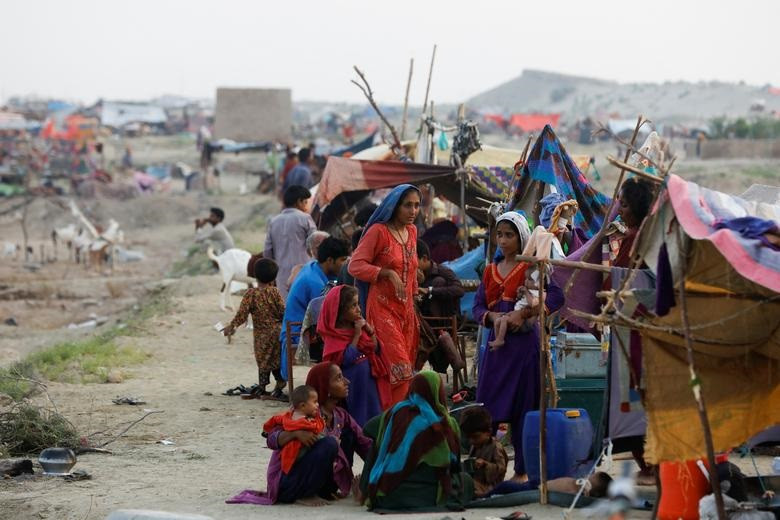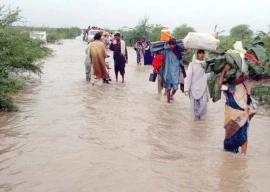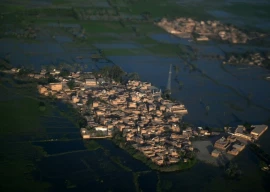
Children and women are becoming more vulnerable as tens of thousands of people suffer from infectious and water-borne diseases in flood-hit Pakistan, government data showed and UNICEF said on Friday, as the total death toll from the inundation surpassed 1,500.
As flood waters begin to drain away, which officials say may take two to six months in different areas, the flooded regions have become infested with diseases including malaria, dengue fever, diarrhoea and skin problems, the Sindh government said in a report issued on Friday.
"Stagnant water is giving rise to the water-borne diseases," Prime Minister Shehbaz Sharif said in his address to the Shanghai Cooperation Organisation (SCO) summit being held in Samarkand in Uzbekistan.
"Children getting malaria and diarrhoea ... all kinds of diseases," he said, adding, "millions of people are living under open sky".
The Sindh report said more than 90,000 people were treated on Thursday alone in the province, which has been the hardest hit by the cataclysmic floods.
It confirmed 588 malaria cases with another 10,604 suspected cases, in addition to the 17,977 diarrhoea and 20,064 skin disease cases reported on Thursday.
A total of 2.3 million patients have been treated since July 1 in the field and mobile hospitals set up in the flooded region.
Record monsoon rains in south and southwest Pakistan and glacial melt in northern areas triggered the flooding that has impacted nearly 33 million people in the South Asian nation of 220 million, sweeping away homes, crops, bridges, roads and livestock in damages estimated at $30 billion.
The losses will slash the country's GDP growth to around 3% from the estimated target of 5% set out in the budget at a time when it had narrowly escaped defaulting on its debt amid a balance of payment crisis.
Pakistan was already reeling from economic blows when the floods hit, with its foreign reserves falling to as low as one month's worth of imports and its current account deficit widening. The economy has yet to show any positive response to Islamabad resuming an IMF programme that had been delayed since early this year.
The Pakistani rupee has been tumbling and inflation has topped 27%. The National Disaster Management Authority has reported 1,508 deaths due to the floods so far, including 536 children and 308 women.
Hundreds of thousands of people who have been displaced are in dire need of food, shelter, clean drinking water, toilets and medicines.
Many have been sleeping in the open by the side of elevated highways. "I have been in flood-affected areas for the past two days. The situation for families is beyond bleak, and the stories I heard paint a desperate picture," said Abdullah Fadil, UNICEF Representative in Pakistan.
"All of us on the ground see malnourished children battling diarrhoea and malaria, dengue fever, and many with painful skin conditions," he said in a statement.
He said a lot of the mothers were anaemic and malnourished themselves, and with very low-weight babies that are exhausted or ill and unable to breastfeed. Millions of families are now living with little more than rags to protect themselves from the scorching sun as temperatures in some areas pass 40 degrees Celsius, Fadil said.
The torrential monsoon, which submerged huge swathes of Pakistan, was a one in a hundred-year event likely made more intense by climate change, scientists said on Thursday.
The country received 391 mm (15.4 inches) of rain, or some 190% more than the 30-year average through July and August, a monsoon spell that started early and stretched beyond the usual timeline.
Rainfall in the southern province of Sindh shot up to 466% of the average.




1719319701-0/BeFunky-collage-(10)1719319701-0-165x106.webp)
1737547089-0/fizza-(82)1737547089-0-165x106.webp)




1737530468-0/sidra--(12)1737530468-0-270x192.webp)






1737452260-0/Gaddafi-stadium-(2)1737452260-0-270x192.webp)









COMMENTS (3)
Comments are moderated and generally will be posted if they are on-topic and not abusive.
For more information, please see our Comments FAQ